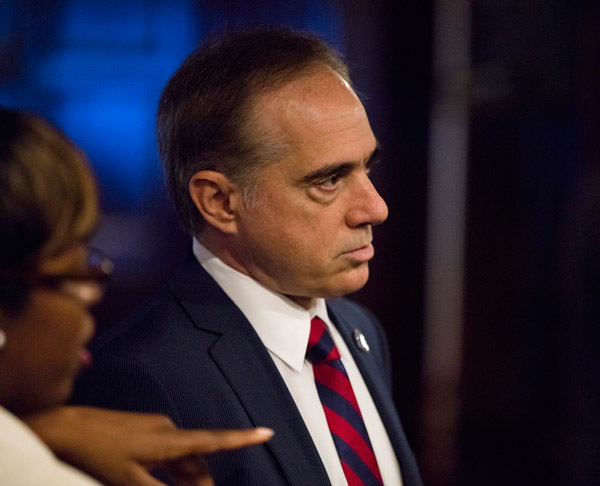With much fanfare, Dr. David Shulkin, the new Secretary for the Department of Veterans Affairs (“the VA”), has moved quickly to address some of the recurring problems at the VA.
As the first VA Secretary without a military background, Dr. Shulkin appears committed to resolve several pressing concerns:
– Speedier processing of Veteran benefit claims and,
– Eliminate unnecessary bureaucracy and artificial constraints on “out-of-network” support for Veterans (Choice Program).
Indeed, Secretary Shulkin recently unveiled a 10 Point Plan to modernize the VA:
1. Firing bad employees
2. Extending the Choice program
3. Choice 2.0
4. Improving VA infrastructure
5. ‘World-class’ services
6. Better VA-DoD partnerships
7. Better electronic records
8. Stopping suicide
9. Appeals modernization
10. Internal improvements
While there is little in these Powerpoint presentation bullet points that anyone would quibble with, implementing these broad goals tends to be far more complicated than listing the goals. Unless there are rigorous benchmarks to assess progress toward achieving these goals, then this “goal-setting” exercise is rather fruitless.
In fact, it is difficult to reconcile the need for increased hiring within the VA unless one sees clear and conclusive evidence that “bad employees” are being fired. In fact, the VA is recommending a hiring surge to deal with a backlog of benefit claims, a situation that has persisted for 4 years.
Are more employees needed or does the VA lack the “right” mix of employees to implement Shulkin’s 10 point plan?
For instance, State and Local VA coverage varies radically across the US. For example, NPR reported in 2015 “that spending is nearly $30,000 per patient in San Francisco, and less than $7,000 per patient in Lubbock, Texas. Nationally, the average is just under $10,000. In places where more veterans are enrolled in VA health benefit plans, spending per veteran did tend to be higher.” Why? This is a huge variance that is not well explained.
Aligning the VA to Achieve Measurable Goals
As one looks at Shulkin’s proposed goals, it would be useful to determine their priority and the level of commitment (personnel and capital expenditure) that is required to attain them. Furthermore, what are the benchmarks to chart progress toward achieving those goals.
For instance, “stopping Veteran suicides” is a goal that would find few naysayers. Nevertheless, it is difficult to reconcile that goal with the sad fact that 30% of suicide watch calls are not currently attended by the Veteran Crisis Center. Indeed, I find it disturbing that the Suicide Crisis Line has been centralized under the VA in the name of “efficiency.”
Perhaps, Dr. Shulkin and his staff have some measurable goals. If so, they should be made public and both the Executive Body and Congressional Oversight Committees should receive regular updates from the VA on progress to date in achieving mutually agreeable goals.
Is this likely to happen? Most certainly not! This is an anathema to Big Government.
Is Firing Bad Employees Really Going to Occur?
With 365,000 employees, there are certainly going to be a few “bad eggs.” While Dr. Shulkin praised the vast majority of VA employees, he told a cheering crowd that “We’re going to make sure that the secretary has the authority to make sure that those (sic “bad”) employees … are leaving the VA system.”
Really? It seems to anyone who has taken more than a cursory look at staffing within the VA, that David Cox, the President of the American Federation of Government Employees, will be calling the shots rather than Dr. Shulkin.
In most cases, distinguishing between a “bad” employee and an inefficient one is largely subjective. Given the protection afforded by employees at the VA, it is highly unlikely that both the bad and inefficient employees will be “leaving the VA system” anytime soon.
In effect, this places a greater burden on both ” the good” and the many efficient and competent employees within the VA. With little say or control on managing the workforce, I find it highly unlikely that Dr. Shulkin will be able to fulfill his promise to fire “bad” employees.
More importantly, it is unlikely that he will be able to realign staffing levels to implement his 10-point plan.
And Speaking of Bad Apples: How About Dr. David Cifu?
If Secretary Shulkin is really serious about dealing with “Veteran suicides” and providing Veterans with alternative treatment for Veterans with PTSD, he would do well to question the credentials of Dr. David Cifu and others within the VA who continue to block Veteran access to better treatment alternatives.
When one looks at Secretary Shulkin’s complex agenda, one should focus on the signs that change is actually occurring. Personally, I don’t expect to see much change over the next couple of years, unless there are clear bookmarks to measure that change. Sadly, it seems likely that we will be looking at the same litany of complaints a couple years down the road.
Dr. Shulkin, I admire your bravado and enthusiasm, but question whether you have the right tools and authority at your disposal to bring about a much needed reform within the VA.
Veterans should be hopeful, but not too optimistic.
ShareMAR
2017



About the Author:
Vietnam vintage US Army officer who honors the brave men and women who serve our country.